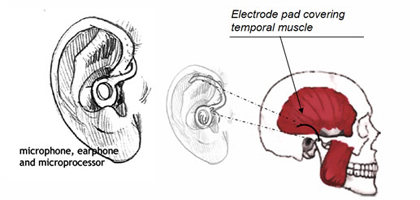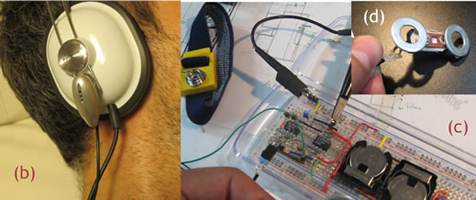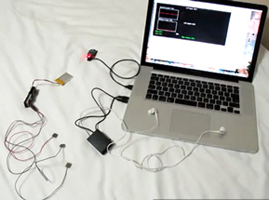Earlids: voluntary control of auditory gain by contraction of mastication muscles
Summary
EARLIDS is a wearable device enabling the semi-voluntary control of auditory gain. Artificial "earlids" represent to the ears what natural eyelids are to the eyes: a fast and efficient reflex mechanism for protecting delicate sensory organs. Externally, the device presents itself as an ordinary pair of closed headphones, but hidden under each ear-cup we find EMG electrodes that monitor the contraction of the temporal and masseter muscles. When they contract or relax (consciously or unconsciously), the external sound being picked by binaural microphones placed on each side of the head will be greatly attenuated - or greatly amplified depending on the mode of operation. Applications may range from instant hearing protection without requiring the use of hands (in particular for people having to work at the boundary of environments with notably different sound levels such as night clubs), to the generation of highly personal acoustic experiences rendered possible by the manipulation of the environmental acoustic material.
 |
In a first prototype, sound is first blocked almost completely by circumaural (ear-cup) headphones; sound is picked by bin-aural microphones and fed to a MAX/MSP patch on a laptop computer. The patch modulates the gain before redirecting the sound stream towards the headphones, using as a control signal the output of a custom made EMG detector based on an INA128 instrumentation amplifier. A second prototype was built using noise canceling ear-buds, coming closer to in-ear 'earlids' (but the processing was done wirelessly on a laptop computer - bottom/right image). This second prototype was made using a wireless myoelectric sensor graciously provided by Daito Manabe and designed by Masaki Teruoka (for more information on this, check "BodyHack" workshop at TEI2010).
 |
 |
Movie
Reference
- A. Cassinelli, EARLIDS & entacoustic performance, Third Workshop on Devices that Alter Perception (DAP 2010) in conjunction with ISMAR 2010, October 13th, 2010, Seoul, South Korea [PDF-1.2MB][Slides-1MB]



